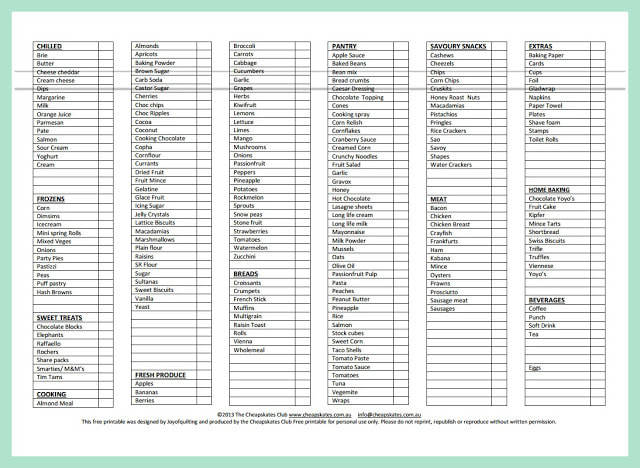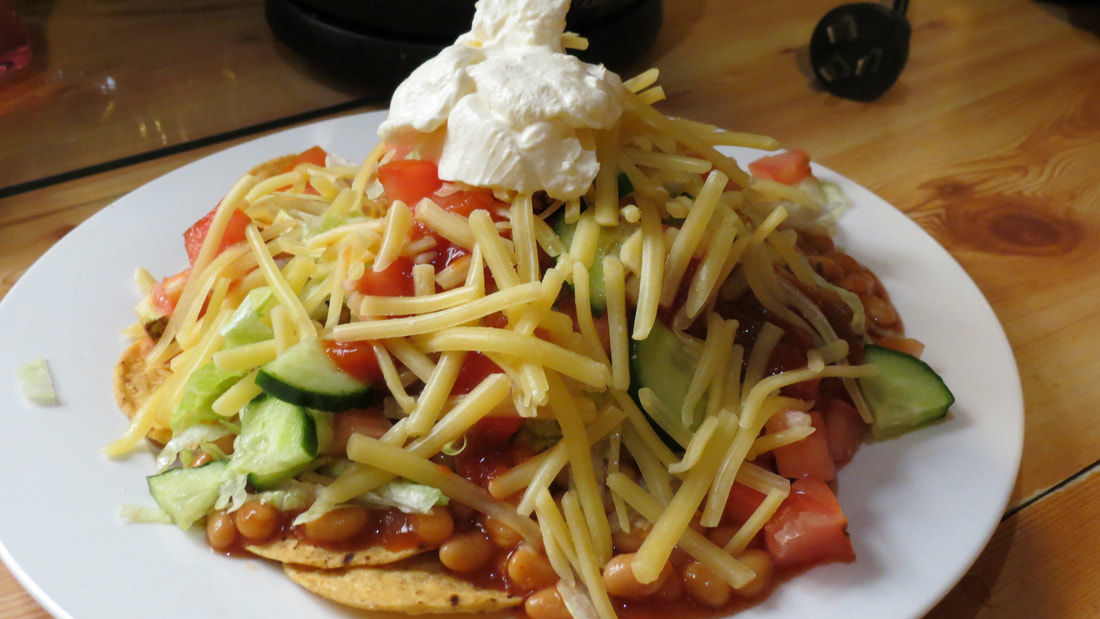|
One question I get every year, usually just after Christmas, is do I think that the Christmas hampers available on the lay-by system are worth the money? And every year my answer is an emphatic no. Because when you break them down, they cost a lot more than the same items would if you were to source them yourself. When you MOO your Christmas hampers you choose what goes into it (you're not stuck with foods you don't like and will never use). You also get to choose when to buy those things (if you're smart you started with the non-perishables earlier in the year and bought them on half-price sale or even better, on clearance). And you choose how much of each thing to put into your hamper. Cheapskaters have their own methods of getting amazing Christmas hampers at rock bottom prices that have exactly what they want in them. If you're not familiar with it, I recommend the Joyco Hamper method. Joyofquilting is a long time Cheapskates Club member (she's also the inventor of Miracles Spray) and a few years ago she posted her template for her very own Joyco Hamper. Joy starts her Christmas grocery shopping early in the year, buying and stockpiling non-perishables and baking supplies and she uses her very detailed hamper template.
I usually start my Christmas/New Year grocery shopping in September and have it all finished when I do the November the shop. The bonus for me is that I buy enough to keep me out of the supermarket until it's time to do the March grocery shop the next year. Then the only things I buy are milk, eggs, bread and some fruit and veg, and only because I can't store enough of those things and keep them fresh for long enough. Why? Mainly because I loathe shopping in the heat and battling crowds during December and shopping during January doesn't appeal either - I want to enjoy our summer holidays. Having the Joyco Hamper template to work off helps me to remember to include the Christmas treats on my shopping lists. Things like ham, turkey, chocolate almonds, drinks, nuts, extra dried fruits, even the bon bons and candles for the table. And I can assure you my version of the Joyco Hamper doesn't cost anywhere $800, or even $400 a la the DIY version on the news. No siree! I budget $120 for our hamper and it includes all of the above, plus the extra veggies, serviettes, cheeses, dips, crackers, olives, pudding and cake ingredients and so on. Enough of my rambling, the point of this post is to share the Joyco Hamper template with you - just click here to download your copy.. As we Cheapskaters have been known to say, "make it your own". Use it as is or add or delete according to your needs. And smile as you shop for your Joyco Hamper because you'll be saving an absolute bundle.
0 Comments
 Oranges are cheap at the moment, and the quality is excellent. Don't forget to check the label to make sure you are buying Australian oranges to ensure they are top quality and of course to support Australian farmers. This cake uses a whole orange and just four other basic pantry items, making it quick and easy. Whole Orange Cake Ingredients: 1 whole orange 1 1/2 cups sugar 3 eggs 1 1/4 cups oil 2 cups SR flour Method: Pre-heat oven to 180 degrees Celsius. Place the whole orange, sugar, eggs and oil in a food processor and blend well. Add sifted flour. Whizz until flour is mixed into orange mixture. Bake in a greased and lined loaf tin for 45 minutes until cooked. Note: Olive oil gives a very moist cake but can leave a “taste”. I like to use half vegetable oil, half olive oil. The result is a lovely moist cake without the taste of the olive oil. This is the original recipe as given to me. I have tweaked it somewhat to suit our eating habits, and the result is a delicious, moist cake, that is more nutritious. After all eating a healthy diet doesn't have to mean eating a dull diet. The recipe I now make swaps wholemeal spelt flour for the self-raising flour and unsweetened apple sauce for the oil. I also cut the amount of sugar in the recipe and replace one of the eggs with flax seed and water (a great egg substitute). The result is a very moist cake, almost a mud cake texture. I also bake it in cupcake papers just to make it go further. I get 24 large cupcakes from the recipe and they take approximately 18 minutes to cook, depending on your oven. I'd start checking them after 15 minutes. The cakes are done when a skewer inserted into the centre comes out clean. I don't have strange ingredients in the back of the pantry. Or rather I don't have ingredients I don't use at the back of the pantry (some of the things I use may be a little strange to some folk). I tend to buy the same basic groceries over and over and over and just rearrange them into different recipes. It means my grocery bill rarely varies from month to month and is predictable, unless of course there is a price rise (drat those price rises). Wendy talked about using coconut milk in a recipe and finding it overpowering, so she gave it another go and that recipe failed the Family Approval Test too. In the end she donated the remaining can of coconut milk to a food drive. I use coconut cream in curry and satay and to make custard. My family likes coconut so it is a pantry staple in our home. Wendy's family isn't so keen on it and so it is an extra ingredient. Those strange ingredients in a recipe will depend on your taste, your budget and your daring as a cook. In the interests of keeping a happy family we try to have one new recipe a month. It may be a main meal or a side dish, it might be a cake or slice, sometimes it is a new jam, sauce or pickle. Everyone takes turns choosing the recipe from the dozens of recipe books on the shelf. Sometimes a new recipe is a hit and goes onto the regular recipe rotation; sometimes it is a dud and we all vow to never, ever try it again (like the infamous SALMON DISH - and yes the kids talk about it in capitals, they shudder at the very mention of it). If a new recipe uses an ingredient that's not in the pantry I try to find a substitute I already have. If I don't have a substitute and I really want to try the recipe I buy the smallest size I can to try it. Then if we like it and it's an ingredient I can use in other things I'll look for the cheapest way to buy it. Here's a list of substitutes you can use when you find you don't have all the ingredients you need for a recipe.
Haystacks are a family favourite and we enjoy them regularly. They're quick and easy to make and topped with lots of lovely fresh veggies they are the perfect easy meal all year round. I've no idea where the name came from, I first started making them about 35 years ago when I was a cook for school camps. The kids loved them because they were "junk" food, we cooks loved them because it is a one-pot wonder recipe, that can be made ahead, and is easy to serve. Now my family loves them, this really is a recipe that has stood the test of time. This recipe is one of the most requested from the Cheapskates Club Recipe File. Every time they are mentioned in a meal plan or a newsletter I get emails asking what they are and for the recipe. Frugal Haystacks Ingredients: 2 tins baked beans in tomato sauce 1 tin red kidney beans (or dried equivalent, soaked and cooked) 3 tbsp MOO taco seasoning (or 1 packet) 2 large onions, finely chopped 2 tins diced tomatoes Method: Sauté onion, add taco seasoning and then beans and tomatoes. Heat through. Serve over corn chips or toasted pita bread or torn mountain bread (I've even put it over pappadums in a pinch) add salad to suit, top with salsa and sour cream. I usually put the salad (lettuce, tomato, cucumber, cheese, salsa, sour cream) out and let them make their own. This makes a double quantity, so half goes in the freezer for the next time. Freezes well and it makes a great filling for stuffed spuds too. Carolyn writes
"I'd be very interested to know whether anyone has any recipes for using leftover hot chips (from the fish & chip shop). We get minimum chips but there's still too much for two. I have made a frittata from them which was good but I'd like to hear what others do." Do you have the answer? If you have a suggestion or idea for Carolyn let us know in the comments below. We'll enter your answer into our Tip of the Week competition, with a one-year membership to the Cheapskates Club as the prize too. Dianne asks
"My husband and I have been married for five months, and are currently living with his parents. This is their wedding gift to us, so we can save as much as possible as a deposit on a home of our own. They offered us rent and utility free living for two years, which we are grateful for. The problem is grocery money (of all things!). Because of our work schedules, my MIL also does the grocery shopping and cooking (she's a great cook, I'm learning heaps) and we split the bill 50-50. Here's the rub: she does all the grocery shopping Coles and refuses to go anywhere else. She doesn't look for markdowns or specials, and flatly refuses to even consider generic brands. Last month our share of the grocery bill was $1,365 - even living rent free, we can't afford that! How can I , at 25 years old and a newlywed, tactfully introduce the idea of smart and frugal, budget shopping without any offence to my mother-in-law, who has been a housewife for 30+ years and has never needed to budget? Do you have the answer? If you can help Dianne let us know, by leaving it in the comments below. We'll enter your answer into our Tip of the Week competition, with a one-year membership to the Cheapskates Club as the prize. And keep an eye open, you may even see your answer in next week's newsletter. Food is one of the necessities in life. It's also something that most of us spend entirely too much money on. Even those who think they're doing well when they do their grocery shopping are often paying more than they need to for their families' food.
By following a few simple rules, you can greatly reduce your weekly food bill. Here they are: 1. Avoid eating out. Going to restaurants is enjoyable, and it's easier than cooking for ourselves. But it's also very expensive compared to eating at home. While there's nothing wrong with enjoying an occasional meal at a restaurant, most of us do so entirely too much. Cooking at home is much more cost effective. 2. Cook from scratch as much as possible. Few of us have the time to bake all of our own bread or make all of our own snacks. But by using more raw ingredients and less prepackaged foods, we can save a lot of money. And freshly cooked food tastes much better and is more nutritious than prepackaged items, so your family will thank you for it. 3. When shopping, make sure you're getting the best possible deal on each item. Figure up the unit cost of each package of everything you buy. For instance, when buying juice, divide the price by the number of mililitres in the bottle to determine the price per ounce. This will tell you which size bottle is the best deal. 4. Don't rule out store brands. For the most part, they are of comparable quality to national brands but priced much lower. Give them a chance, and you might find that you like them just as well. 5. Comparison shop. Comparing prices at different supermarkets could save you a surprising amount on your grocery bill. But don't drive all over town every time you go shopping. That will cost you more in gas than it will save you. Find the store that consistently has the lowest prices on most of the things you buy, and stick with it unless you hear about a great deal on something you use a lot of at another store. 6. Shop wisely for produce. Buy fruits and vegetables that are in season, because they are much less expensive than those that are out of season. And buy from the local farmer's market or co-op if possible. Their produce is usually significantly cheaper since it is grown locally and doesn't have to be transported far. 7. Go shopping in the right frame of mind. Eat before going to the store so you will be less likely to make impulse buys, and leave the kids at home if possible. This way you can focus on buying only what you truly need. From Debt Free, Cashed Up and Laughing When you start guerrilla shopping you begin looking for foods that do double or even triple duty, rather than buying something that will serve one purpose. When you start thinking about it, there are lots of things you buy that can fit more than one recipe, saving you time, money and energy.
Here are five common grocery items you can cross off your list because they are easily replaced by something else you already have or are totally unnecessary in a Real Food diet. 1. Fruit juice. Even 100%, all-natural, organic juice. It’s very high in sugar and is just not essential to your diet. Your whole family will be healthier if you replace the juice with water and encourage them to eat the whole fruit. Have a plate of mixed fruits on the table for each meal and watch it disappear. 2. Sour cream. Plain yogurt can do all the same things sour cream does, so why buy two different products when one will work just as well? MOO your yoghurt for greater savings then use it to replace cream cheese too. 3. Soft drinks. These days we don't even have them for special occasions. Even the drinks with fruit juice added have far too much sugar or worse still, sugar substitutes. You don't need them. 4. Cold cereals. We all know the sugary kids’ cereals are bad for us, and hopefully, if you've been following the Real Food Challenge, you’ve already eliminated those from your diet. But even the healthiest cereals – which are grossly over-priced – are generally full of sugar and over processed ingredients (including HFCS, flavourings, colourings and preservatives). There are lots of other quick breakfast options: granola, rolled oats, fritters, smoothies, toast, hot cereal, boiled or poached eggs, fruit and yoghurt, ground rice porridge, MOO pancakes or muffins. 5. Anything in a cute little individual packet (or a bulk-buy box). You know: chips, biscuits, muesli bars, fruit leathers, crackers, etc. They are very expensive, not very healthy and there are much nicer, healthier alternatives such as pita chips or zucchini chips, or for a sweet treat Sweet Potato Chocolate Cup Cakes, fruit salad, dried fruits, dips and veggie sticks. From Debt Free, Cashed Up and Laughing |
Archives
April 2020
Categories
All
|





 RSS Feed
RSS Feed